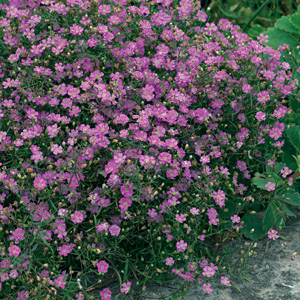Gypsophila Growing Guide

What is Gypsophila?
Gypsophila (Gypsophila paniculata) also known as Baby’s Breath is a hardy perennial herb. It is part of the Caryophyllaceae or carnation family and is native to Europe. It produces masses of small white or pink blooms on tall stems throughout Summer and Autumn. It has fine dark green foliage that has a bushy spreading habit. It prefers a full sun position in the garden that has well drained soil. Gypsophila is frost tolerant.
Benefits of Growing Gypsophila
Gypsophila is a low maintenance plant that is well known more for its addition to floral arrangements than planted in the garden. When placed in the garden the flowers can lighten up different areas of the garden with their fine swaying blooms. Grow these plants for their tiny white or pink flowers to use in bouquets or flower arrangement. To use the flowers in flower arrangements, cut them when half the blooms are open. The remaining blooms will open after a few days. To dry baby’s breath, cut them early in the morning when the blooms are just opening. For 2 weeks hang them in a dry, warm location. Their flowers attracts butterflies and would look great in a cottage garden setting.
How to Grow Gypsophila
Climatic Zones
Cool, temperate, arid, semi arid.
Plant Size
Height: 60-90cm, Width: 60-90cm
When To Plant Gypsophila
Plant in Spring.
Soil Preparation
They like well drained humus rich soil. If the soil is heavy (clay soils) mix through plenty of organic matter, such as compost or broken down animal manure because the plants will rot during long, wet Winters.
How To Plant Gypsophila
Plant in full sun, 30cm-50cm apart with the plant crown at soil level.
Gypsophila Plant Care
Requires little water once establish. Water when rainfall isn’t sufficient.
An application of a slow release fertiliser during Spring will help your plants put on a wonderful show when flowering season approaches.
Trimming off dead flowers stems once the blooms have faded as this can usually encourage a second run of flowers. During Winter they become dormant cut back to a few cm above ground level.
These plants can be divided after a few years. Simply dig up and divide clumps during Winter then replant as soon as possible.However the fleshy roots are fragile and easily damaged.







